HRM Report: A Comparative Study of Tesco and Walmart's HRM
VerifiedAdded on 2023/01/04
|9
|2440
|37
Report
AI Summary
This report provides a comprehensive analysis of Human Resource Management (HRM) practices, focusing on talent management strategies employed by Tesco and Walmart. It delves into the evolution of HRM, highlighting its critical role in building human capital, managing employees, and fostering positive relationships. The report explores key HRM functions, including recruitment, training, and development, and examines the strategic focus of HRM in achieving organizational goals through job descriptions, coaching, recognition, and creating a healthy work environment. Furthermore, the report compares HRM approaches in Eastern and Western countries, contrasting organizational structures, motivation programs, communication styles, conflict resolution methods, and employee engagement strategies. The analysis reveals significant differences in leadership styles, reward systems, and communication methods, offering insights into the impact of cultural contexts on HRM practices. The report concludes by summarizing the key findings and emphasizing the importance of adapting HRM strategies to suit organizational needs and cultural differences.
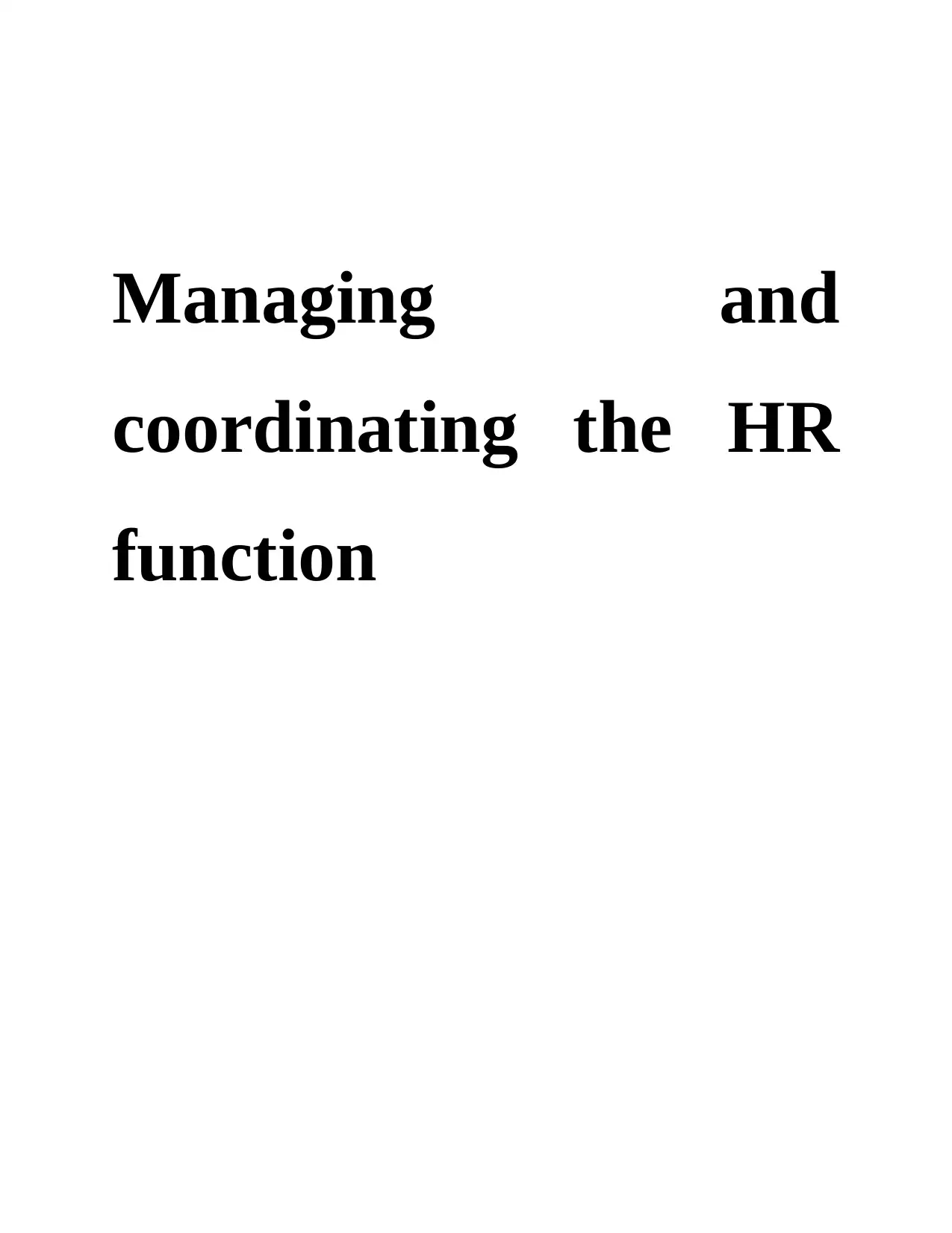
Managing and
coordinating the HR
function
coordinating the HR
function
Paraphrase This Document
Need a fresh take? Get an instant paraphrase of this document with our AI Paraphraser

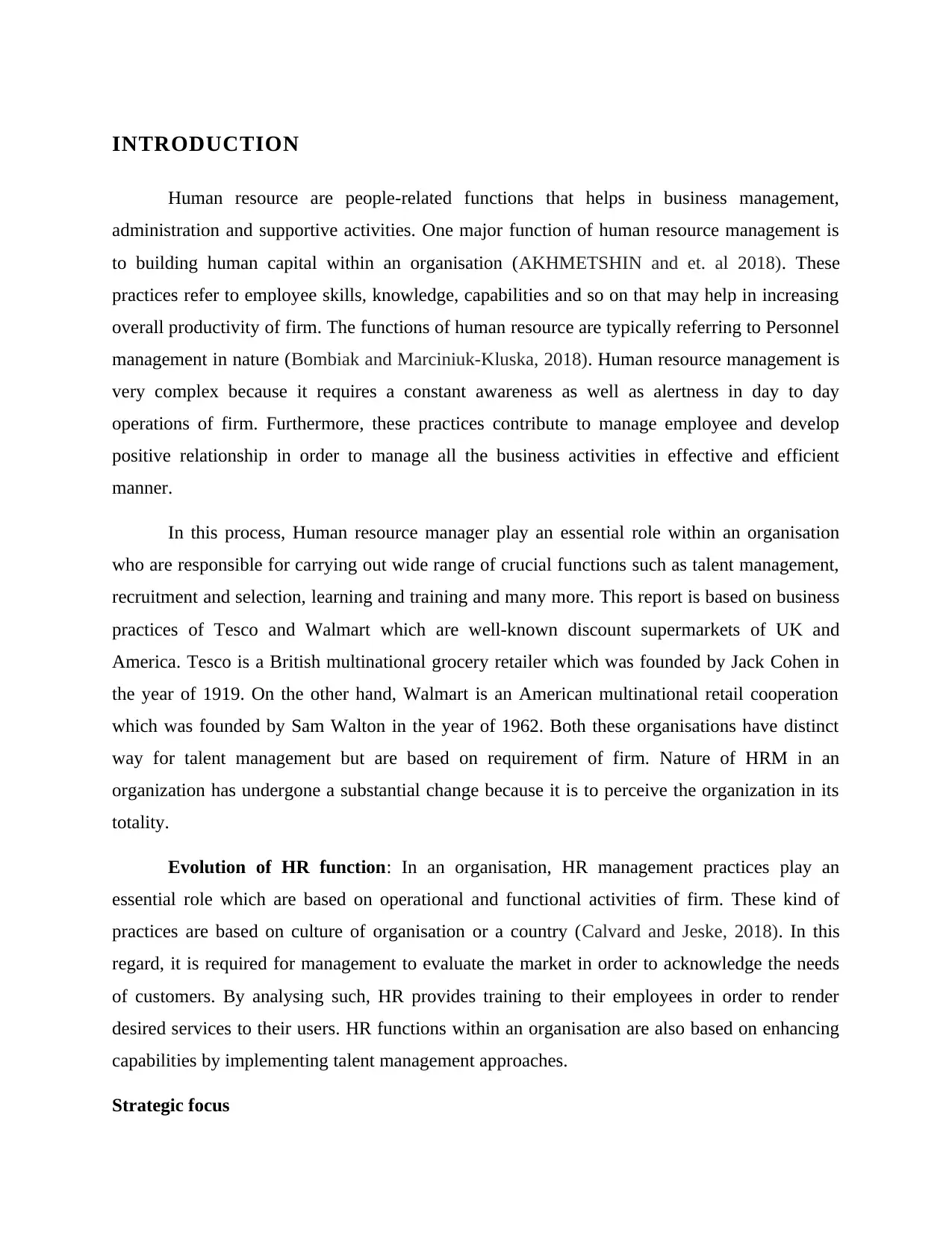
INTRODUCTION
Human resource are people-related functions that helps in business management,
administration and supportive activities. One major function of human resource management is
to building human capital within an organisation (AKHMETSHIN and et. al 2018). These
practices refer to employee skills, knowledge, capabilities and so on that may help in increasing
overall productivity of firm. The functions of human resource are typically referring to Personnel
management in nature (Bombiak and Marciniuk-Kluska, 2018). Human resource management is
very complex because it requires a constant awareness as well as alertness in day to day
operations of firm. Furthermore, these practices contribute to manage employee and develop
positive relationship in order to manage all the business activities in effective and efficient
manner.
In this process, Human resource manager play an essential role within an organisation
who are responsible for carrying out wide range of crucial functions such as talent management,
recruitment and selection, learning and training and many more. This report is based on business
practices of Tesco and Walmart which are well-known discount supermarkets of UK and
America. Tesco is a British multinational grocery retailer which was founded by Jack Cohen in
the year of 1919. On the other hand, Walmart is an American multinational retail cooperation
which was founded by Sam Walton in the year of 1962. Both these organisations have distinct
way for talent management but are based on requirement of firm. Nature of HRM in an
organization has undergone a substantial change because it is to perceive the organization in its
totality.
Evolution of HR function: In an organisation, HR management practices play an
essential role which are based on operational and functional activities of firm. These kind of
practices are based on culture of organisation or a country (Calvard and Jeske, 2018). In this
regard, it is required for management to evaluate the market in order to acknowledge the needs
of customers. By analysing such, HR provides training to their employees in order to render
desired services to their users. HR functions within an organisation are also based on enhancing
capabilities by implementing talent management approaches.
Strategic focus
Human resource are people-related functions that helps in business management,
administration and supportive activities. One major function of human resource management is
to building human capital within an organisation (AKHMETSHIN and et. al 2018). These
practices refer to employee skills, knowledge, capabilities and so on that may help in increasing
overall productivity of firm. The functions of human resource are typically referring to Personnel
management in nature (Bombiak and Marciniuk-Kluska, 2018). Human resource management is
very complex because it requires a constant awareness as well as alertness in day to day
operations of firm. Furthermore, these practices contribute to manage employee and develop
positive relationship in order to manage all the business activities in effective and efficient
manner.
In this process, Human resource manager play an essential role within an organisation
who are responsible for carrying out wide range of crucial functions such as talent management,
recruitment and selection, learning and training and many more. This report is based on business
practices of Tesco and Walmart which are well-known discount supermarkets of UK and
America. Tesco is a British multinational grocery retailer which was founded by Jack Cohen in
the year of 1919. On the other hand, Walmart is an American multinational retail cooperation
which was founded by Sam Walton in the year of 1962. Both these organisations have distinct
way for talent management but are based on requirement of firm. Nature of HRM in an
organization has undergone a substantial change because it is to perceive the organization in its
totality.
Evolution of HR function: In an organisation, HR management practices play an
essential role which are based on operational and functional activities of firm. These kind of
practices are based on culture of organisation or a country (Calvard and Jeske, 2018). In this
regard, it is required for management to evaluate the market in order to acknowledge the needs
of customers. By analysing such, HR provides training to their employees in order to render
desired services to their users. HR functions within an organisation are also based on enhancing
capabilities by implementing talent management approaches.
Strategic focus
⊘ This is a preview!⊘
Do you want full access?
Subscribe today to unlock all pages.

Trusted by 1+ million students worldwide
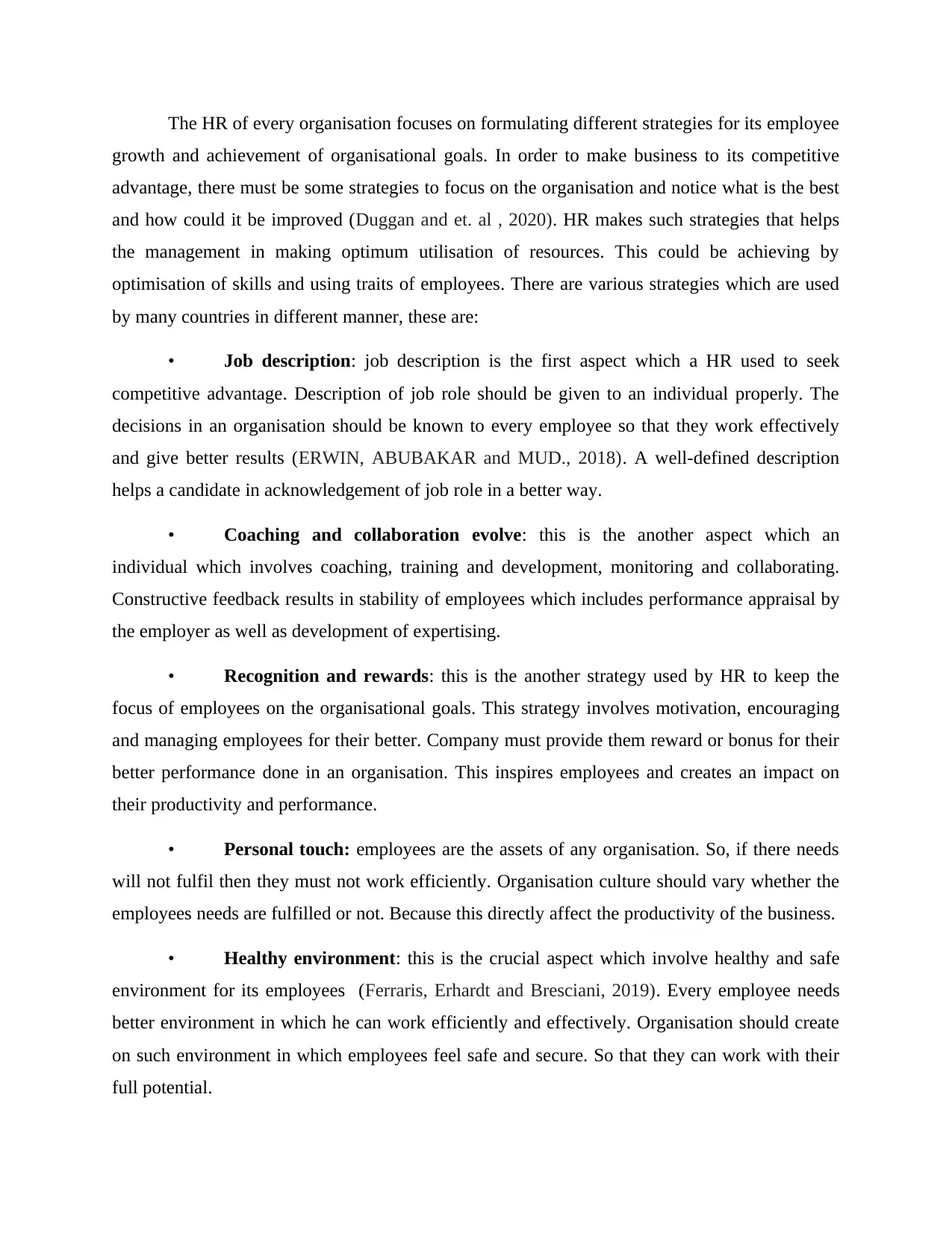
The HR of every organisation focuses on formulating different strategies for its employee
growth and achievement of organisational goals. In order to make business to its competitive
advantage, there must be some strategies to focus on the organisation and notice what is the best
and how could it be improved (Duggan and et. al , 2020). HR makes such strategies that helps
the management in making optimum utilisation of resources. This could be achieving by
optimisation of skills and using traits of employees. There are various strategies which are used
by many countries in different manner, these are:
• Job description: job description is the first aspect which a HR used to seek
competitive advantage. Description of job role should be given to an individual properly. The
decisions in an organisation should be known to every employee so that they work effectively
and give better results (ERWIN, ABUBAKAR and MUD., 2018). A well-defined description
helps a candidate in acknowledgement of job role in a better way.
• Coaching and collaboration evolve: this is the another aspect which an
individual which involves coaching, training and development, monitoring and collaborating.
Constructive feedback results in stability of employees which includes performance appraisal by
the employer as well as development of expertising.
• Recognition and rewards: this is the another strategy used by HR to keep the
focus of employees on the organisational goals. This strategy involves motivation, encouraging
and managing employees for their better. Company must provide them reward or bonus for their
better performance done in an organisation. This inspires employees and creates an impact on
their productivity and performance.
• Personal touch: employees are the assets of any organisation. So, if there needs
will not fulfil then they must not work efficiently. Organisation culture should vary whether the
employees needs are fulfilled or not. Because this directly affect the productivity of the business.
• Healthy environment: this is the crucial aspect which involve healthy and safe
environment for its employees (Ferraris, Erhardt and Bresciani, 2019). Every employee needs
better environment in which he can work efficiently and effectively. Organisation should create
on such environment in which employees feel safe and secure. So that they can work with their
full potential.
growth and achievement of organisational goals. In order to make business to its competitive
advantage, there must be some strategies to focus on the organisation and notice what is the best
and how could it be improved (Duggan and et. al , 2020). HR makes such strategies that helps
the management in making optimum utilisation of resources. This could be achieving by
optimisation of skills and using traits of employees. There are various strategies which are used
by many countries in different manner, these are:
• Job description: job description is the first aspect which a HR used to seek
competitive advantage. Description of job role should be given to an individual properly. The
decisions in an organisation should be known to every employee so that they work effectively
and give better results (ERWIN, ABUBAKAR and MUD., 2018). A well-defined description
helps a candidate in acknowledgement of job role in a better way.
• Coaching and collaboration evolve: this is the another aspect which an
individual which involves coaching, training and development, monitoring and collaborating.
Constructive feedback results in stability of employees which includes performance appraisal by
the employer as well as development of expertising.
• Recognition and rewards: this is the another strategy used by HR to keep the
focus of employees on the organisational goals. This strategy involves motivation, encouraging
and managing employees for their better. Company must provide them reward or bonus for their
better performance done in an organisation. This inspires employees and creates an impact on
their productivity and performance.
• Personal touch: employees are the assets of any organisation. So, if there needs
will not fulfil then they must not work efficiently. Organisation culture should vary whether the
employees needs are fulfilled or not. Because this directly affect the productivity of the business.
• Healthy environment: this is the crucial aspect which involve healthy and safe
environment for its employees (Ferraris, Erhardt and Bresciani, 2019). Every employee needs
better environment in which he can work efficiently and effectively. Organisation should create
on such environment in which employees feel safe and secure. So that they can work with their
full potential.
Paraphrase This Document
Need a fresh take? Get an instant paraphrase of this document with our AI Paraphraser
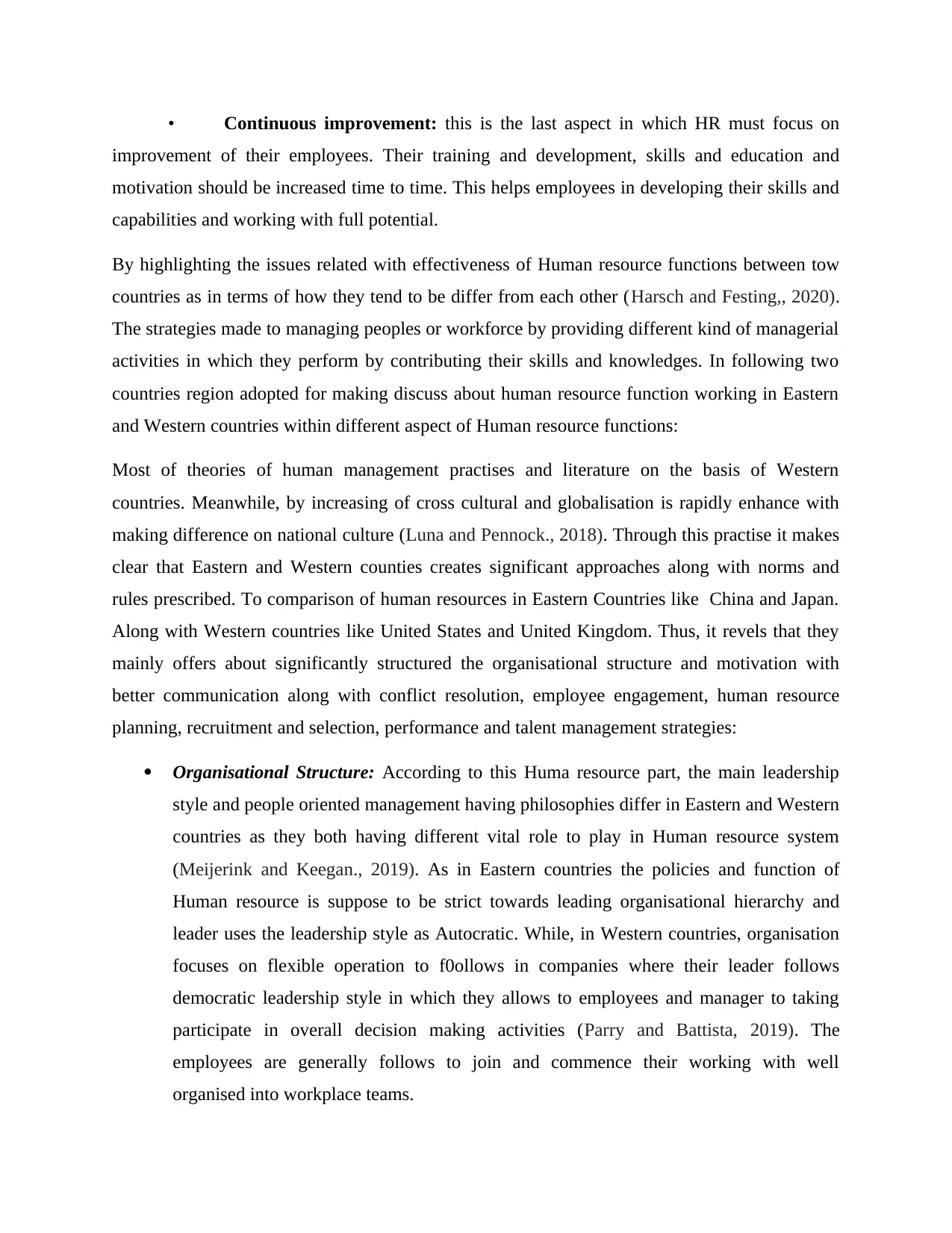
• Continuous improvement: this is the last aspect in which HR must focus on
improvement of their employees. Their training and development, skills and education and
motivation should be increased time to time. This helps employees in developing their skills and
capabilities and working with full potential.
By highlighting the issues related with effectiveness of Human resource functions between tow
countries as in terms of how they tend to be differ from each other (Harsch and Festing,, 2020).
The strategies made to managing peoples or workforce by providing different kind of managerial
activities in which they perform by contributing their skills and knowledges. In following two
countries region adopted for making discuss about human resource function working in Eastern
and Western countries within different aspect of Human resource functions:
Most of theories of human management practises and literature on the basis of Western
countries. Meanwhile, by increasing of cross cultural and globalisation is rapidly enhance with
making difference on national culture (Luna and Pennock., 2018). Through this practise it makes
clear that Eastern and Western counties creates significant approaches along with norms and
rules prescribed. To comparison of human resources in Eastern Countries like China and Japan.
Along with Western countries like United States and United Kingdom. Thus, it revels that they
mainly offers about significantly structured the organisational structure and motivation with
better communication along with conflict resolution, employee engagement, human resource
planning, recruitment and selection, performance and talent management strategies:
Organisational Structure: According to this Huma resource part, the main leadership
style and people oriented management having philosophies differ in Eastern and Western
countries as they both having different vital role to play in Human resource system
(Meijerink and Keegan., 2019). As in Eastern countries the policies and function of
Human resource is suppose to be strict towards leading organisational hierarchy and
leader uses the leadership style as Autocratic. While, in Western countries, organisation
focuses on flexible operation to f0ollows in companies where their leader follows
democratic leadership style in which they allows to employees and manager to taking
participate in overall decision making activities (Parry and Battista, 2019). The
employees are generally follows to join and commence their working with well
organised into workplace teams.
improvement of their employees. Their training and development, skills and education and
motivation should be increased time to time. This helps employees in developing their skills and
capabilities and working with full potential.
By highlighting the issues related with effectiveness of Human resource functions between tow
countries as in terms of how they tend to be differ from each other (Harsch and Festing,, 2020).
The strategies made to managing peoples or workforce by providing different kind of managerial
activities in which they perform by contributing their skills and knowledges. In following two
countries region adopted for making discuss about human resource function working in Eastern
and Western countries within different aspect of Human resource functions:
Most of theories of human management practises and literature on the basis of Western
countries. Meanwhile, by increasing of cross cultural and globalisation is rapidly enhance with
making difference on national culture (Luna and Pennock., 2018). Through this practise it makes
clear that Eastern and Western counties creates significant approaches along with norms and
rules prescribed. To comparison of human resources in Eastern Countries like China and Japan.
Along with Western countries like United States and United Kingdom. Thus, it revels that they
mainly offers about significantly structured the organisational structure and motivation with
better communication along with conflict resolution, employee engagement, human resource
planning, recruitment and selection, performance and talent management strategies:
Organisational Structure: According to this Huma resource part, the main leadership
style and people oriented management having philosophies differ in Eastern and Western
countries as they both having different vital role to play in Human resource system
(Meijerink and Keegan., 2019). As in Eastern countries the policies and function of
Human resource is suppose to be strict towards leading organisational hierarchy and
leader uses the leadership style as Autocratic. While, in Western countries, organisation
focuses on flexible operation to f0ollows in companies where their leader follows
democratic leadership style in which they allows to employees and manager to taking
participate in overall decision making activities (Parry and Battista, 2019). The
employees are generally follows to join and commence their working with well
organised into workplace teams.
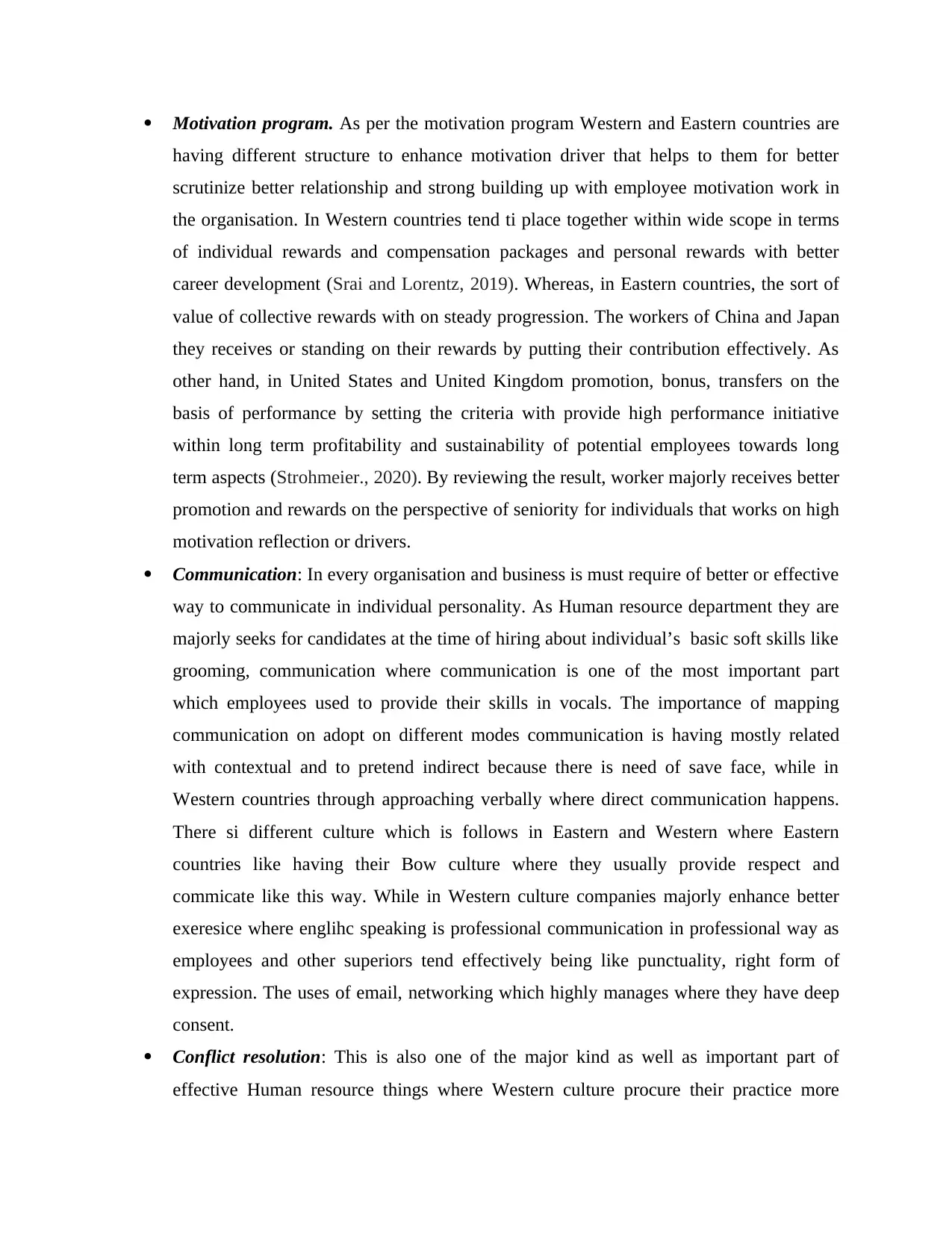
Motivation program. As per the motivation program Western and Eastern countries are
having different structure to enhance motivation driver that helps to them for better
scrutinize better relationship and strong building up with employee motivation work in
the organisation. In Western countries tend ti place together within wide scope in terms
of individual rewards and compensation packages and personal rewards with better
career development (Srai and Lorentz, 2019). Whereas, in Eastern countries, the sort of
value of collective rewards with on steady progression. The workers of China and Japan
they receives or standing on their rewards by putting their contribution effectively. As
other hand, in United States and United Kingdom promotion, bonus, transfers on the
basis of performance by setting the criteria with provide high performance initiative
within long term profitability and sustainability of potential employees towards long
term aspects (Strohmeier., 2020). By reviewing the result, worker majorly receives better
promotion and rewards on the perspective of seniority for individuals that works on high
motivation reflection or drivers.
Communication: In every organisation and business is must require of better or effective
way to communicate in individual personality. As Human resource department they are
majorly seeks for candidates at the time of hiring about individual’s basic soft skills like
grooming, communication where communication is one of the most important part
which employees used to provide their skills in vocals. The importance of mapping
communication on adopt on different modes communication is having mostly related
with contextual and to pretend indirect because there is need of save face, while in
Western countries through approaching verbally where direct communication happens.
There si different culture which is follows in Eastern and Western where Eastern
countries like having their Bow culture where they usually provide respect and
commicate like this way. While in Western culture companies majorly enhance better
exeresice where englihc speaking is professional communication in professional way as
employees and other superiors tend effectively being like punctuality, right form of
expression. The uses of email, networking which highly manages where they have deep
consent.
Conflict resolution: This is also one of the major kind as well as important part of
effective Human resource things where Western culture procure their practice more
having different structure to enhance motivation driver that helps to them for better
scrutinize better relationship and strong building up with employee motivation work in
the organisation. In Western countries tend ti place together within wide scope in terms
of individual rewards and compensation packages and personal rewards with better
career development (Srai and Lorentz, 2019). Whereas, in Eastern countries, the sort of
value of collective rewards with on steady progression. The workers of China and Japan
they receives or standing on their rewards by putting their contribution effectively. As
other hand, in United States and United Kingdom promotion, bonus, transfers on the
basis of performance by setting the criteria with provide high performance initiative
within long term profitability and sustainability of potential employees towards long
term aspects (Strohmeier., 2020). By reviewing the result, worker majorly receives better
promotion and rewards on the perspective of seniority for individuals that works on high
motivation reflection or drivers.
Communication: In every organisation and business is must require of better or effective
way to communicate in individual personality. As Human resource department they are
majorly seeks for candidates at the time of hiring about individual’s basic soft skills like
grooming, communication where communication is one of the most important part
which employees used to provide their skills in vocals. The importance of mapping
communication on adopt on different modes communication is having mostly related
with contextual and to pretend indirect because there is need of save face, while in
Western countries through approaching verbally where direct communication happens.
There si different culture which is follows in Eastern and Western where Eastern
countries like having their Bow culture where they usually provide respect and
commicate like this way. While in Western culture companies majorly enhance better
exeresice where englihc speaking is professional communication in professional way as
employees and other superiors tend effectively being like punctuality, right form of
expression. The uses of email, networking which highly manages where they have deep
consent.
Conflict resolution: This is also one of the major kind as well as important part of
effective Human resource things where Western culture procure their practice more
⊘ This is a preview!⊘
Do you want full access?
Subscribe today to unlock all pages.

Trusted by 1+ million students worldwide
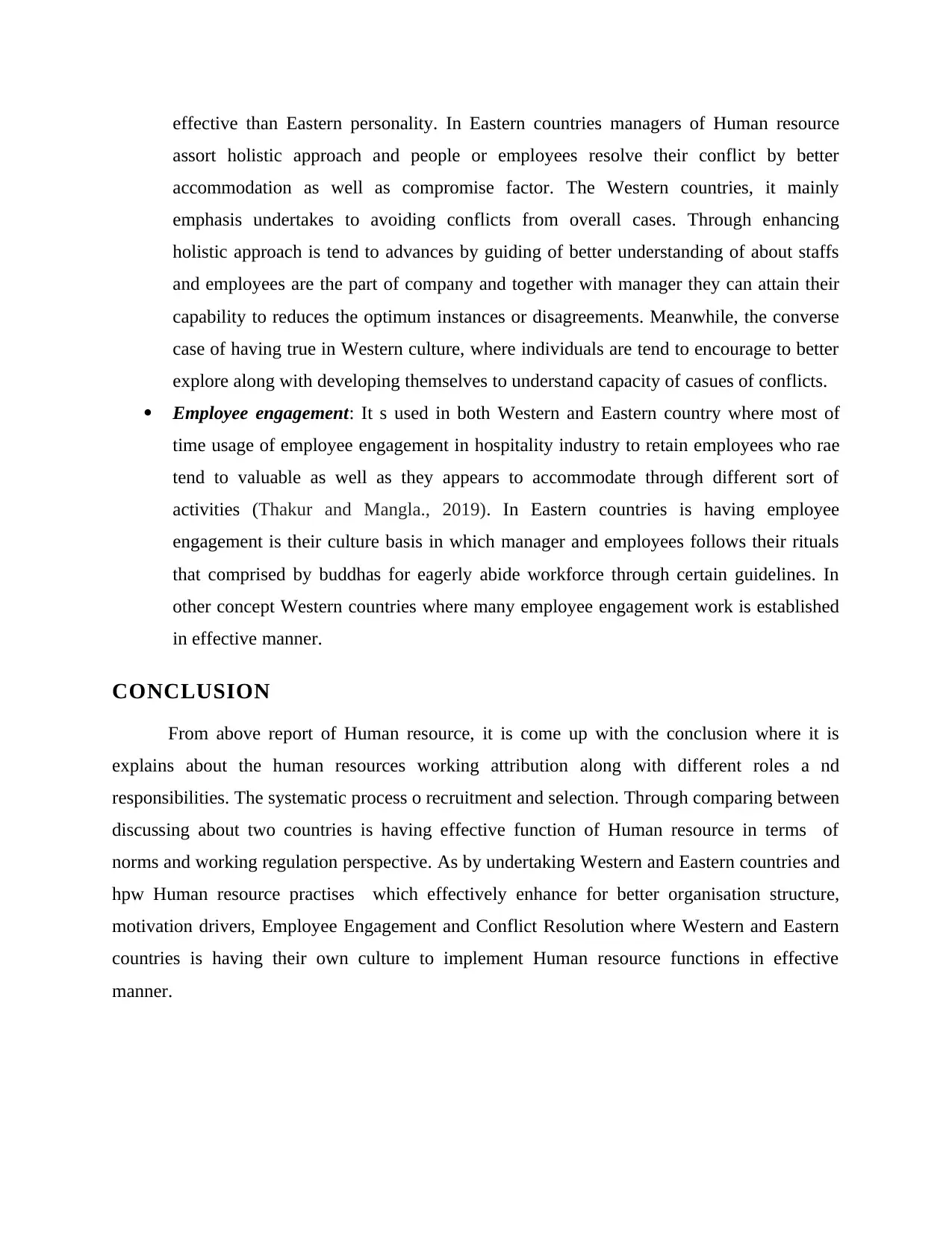
effective than Eastern personality. In Eastern countries managers of Human resource
assort holistic approach and people or employees resolve their conflict by better
accommodation as well as compromise factor. The Western countries, it mainly
emphasis undertakes to avoiding conflicts from overall cases. Through enhancing
holistic approach is tend to advances by guiding of better understanding of about staffs
and employees are the part of company and together with manager they can attain their
capability to reduces the optimum instances or disagreements. Meanwhile, the converse
case of having true in Western culture, where individuals are tend to encourage to better
explore along with developing themselves to understand capacity of casues of conflicts.
Employee engagement: It s used in both Western and Eastern country where most of
time usage of employee engagement in hospitality industry to retain employees who rae
tend to valuable as well as they appears to accommodate through different sort of
activities (Thakur and Mangla., 2019). In Eastern countries is having employee
engagement is their culture basis in which manager and employees follows their rituals
that comprised by buddhas for eagerly abide workforce through certain guidelines. In
other concept Western countries where many employee engagement work is established
in effective manner.
CONCLUSION
From above report of Human resource, it is come up with the conclusion where it is
explains about the human resources working attribution along with different roles a nd
responsibilities. The systematic process o recruitment and selection. Through comparing between
discussing about two countries is having effective function of Human resource in terms of
norms and working regulation perspective. As by undertaking Western and Eastern countries and
hpw Human resource practises which effectively enhance for better organisation structure,
motivation drivers, Employee Engagement and Conflict Resolution where Western and Eastern
countries is having their own culture to implement Human resource functions in effective
manner.
assort holistic approach and people or employees resolve their conflict by better
accommodation as well as compromise factor. The Western countries, it mainly
emphasis undertakes to avoiding conflicts from overall cases. Through enhancing
holistic approach is tend to advances by guiding of better understanding of about staffs
and employees are the part of company and together with manager they can attain their
capability to reduces the optimum instances or disagreements. Meanwhile, the converse
case of having true in Western culture, where individuals are tend to encourage to better
explore along with developing themselves to understand capacity of casues of conflicts.
Employee engagement: It s used in both Western and Eastern country where most of
time usage of employee engagement in hospitality industry to retain employees who rae
tend to valuable as well as they appears to accommodate through different sort of
activities (Thakur and Mangla., 2019). In Eastern countries is having employee
engagement is their culture basis in which manager and employees follows their rituals
that comprised by buddhas for eagerly abide workforce through certain guidelines. In
other concept Western countries where many employee engagement work is established
in effective manner.
CONCLUSION
From above report of Human resource, it is come up with the conclusion where it is
explains about the human resources working attribution along with different roles a nd
responsibilities. The systematic process o recruitment and selection. Through comparing between
discussing about two countries is having effective function of Human resource in terms of
norms and working regulation perspective. As by undertaking Western and Eastern countries and
hpw Human resource practises which effectively enhance for better organisation structure,
motivation drivers, Employee Engagement and Conflict Resolution where Western and Eastern
countries is having their own culture to implement Human resource functions in effective
manner.
Paraphrase This Document
Need a fresh take? Get an instant paraphrase of this document with our AI Paraphraser
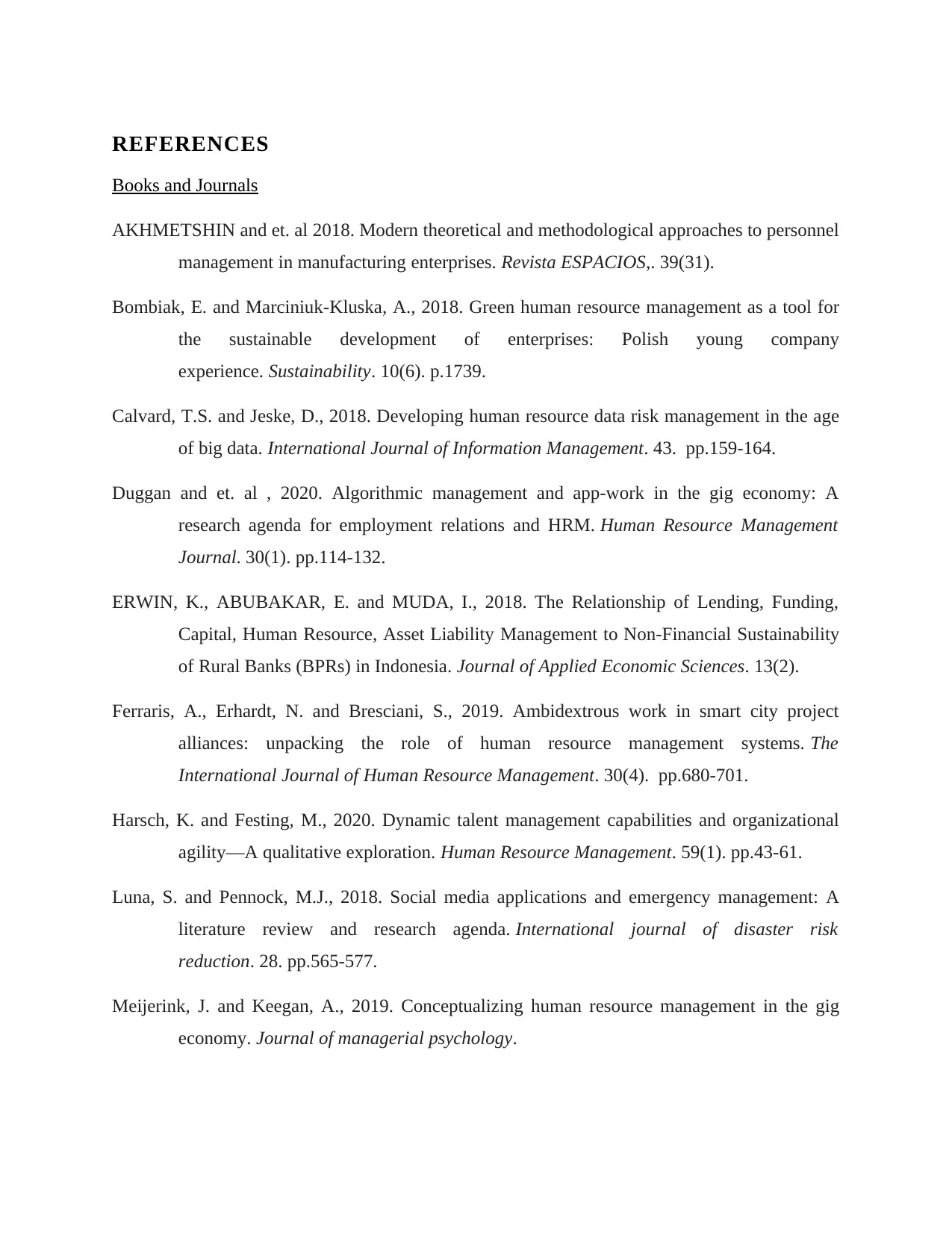
REFERENCES
Books and Journals
AKHMETSHIN and et. al 2018. Modern theoretical and methodological approaches to personnel
management in manufacturing enterprises. Revista ESPACIOS,. 39(31).
Bombiak, E. and Marciniuk-Kluska, A., 2018. Green human resource management as a tool for
the sustainable development of enterprises: Polish young company
experience. Sustainability. 10(6). p.1739.
Calvard, T.S. and Jeske, D., 2018. Developing human resource data risk management in the age
of big data. International Journal of Information Management. 43. pp.159-164.
Duggan and et. al , 2020. Algorithmic management and app‐work in the gig economy: A
research agenda for employment relations and HRM. Human Resource Management
Journal. 30(1). pp.114-132.
ERWIN, K., ABUBAKAR, E. and MUDA, I., 2018. The Relationship of Lending, Funding,
Capital, Human Resource, Asset Liability Management to Non-Financial Sustainability
of Rural Banks (BPRs) in Indonesia. Journal of Applied Economic Sciences. 13(2).
Ferraris, A., Erhardt, N. and Bresciani, S., 2019. Ambidextrous work in smart city project
alliances: unpacking the role of human resource management systems. The
International Journal of Human Resource Management. 30(4). pp.680-701.
Harsch, K. and Festing, M., 2020. Dynamic talent management capabilities and organizational
agility—A qualitative exploration. Human Resource Management. 59(1). pp.43-61.
Luna, S. and Pennock, M.J., 2018. Social media applications and emergency management: A
literature review and research agenda. International journal of disaster risk
reduction. 28. pp.565-577.
Meijerink, J. and Keegan, A., 2019. Conceptualizing human resource management in the gig
economy. Journal of managerial psychology.
Books and Journals
AKHMETSHIN and et. al 2018. Modern theoretical and methodological approaches to personnel
management in manufacturing enterprises. Revista ESPACIOS,. 39(31).
Bombiak, E. and Marciniuk-Kluska, A., 2018. Green human resource management as a tool for
the sustainable development of enterprises: Polish young company
experience. Sustainability. 10(6). p.1739.
Calvard, T.S. and Jeske, D., 2018. Developing human resource data risk management in the age
of big data. International Journal of Information Management. 43. pp.159-164.
Duggan and et. al , 2020. Algorithmic management and app‐work in the gig economy: A
research agenda for employment relations and HRM. Human Resource Management
Journal. 30(1). pp.114-132.
ERWIN, K., ABUBAKAR, E. and MUDA, I., 2018. The Relationship of Lending, Funding,
Capital, Human Resource, Asset Liability Management to Non-Financial Sustainability
of Rural Banks (BPRs) in Indonesia. Journal of Applied Economic Sciences. 13(2).
Ferraris, A., Erhardt, N. and Bresciani, S., 2019. Ambidextrous work in smart city project
alliances: unpacking the role of human resource management systems. The
International Journal of Human Resource Management. 30(4). pp.680-701.
Harsch, K. and Festing, M., 2020. Dynamic talent management capabilities and organizational
agility—A qualitative exploration. Human Resource Management. 59(1). pp.43-61.
Luna, S. and Pennock, M.J., 2018. Social media applications and emergency management: A
literature review and research agenda. International journal of disaster risk
reduction. 28. pp.565-577.
Meijerink, J. and Keegan, A., 2019. Conceptualizing human resource management in the gig
economy. Journal of managerial psychology.
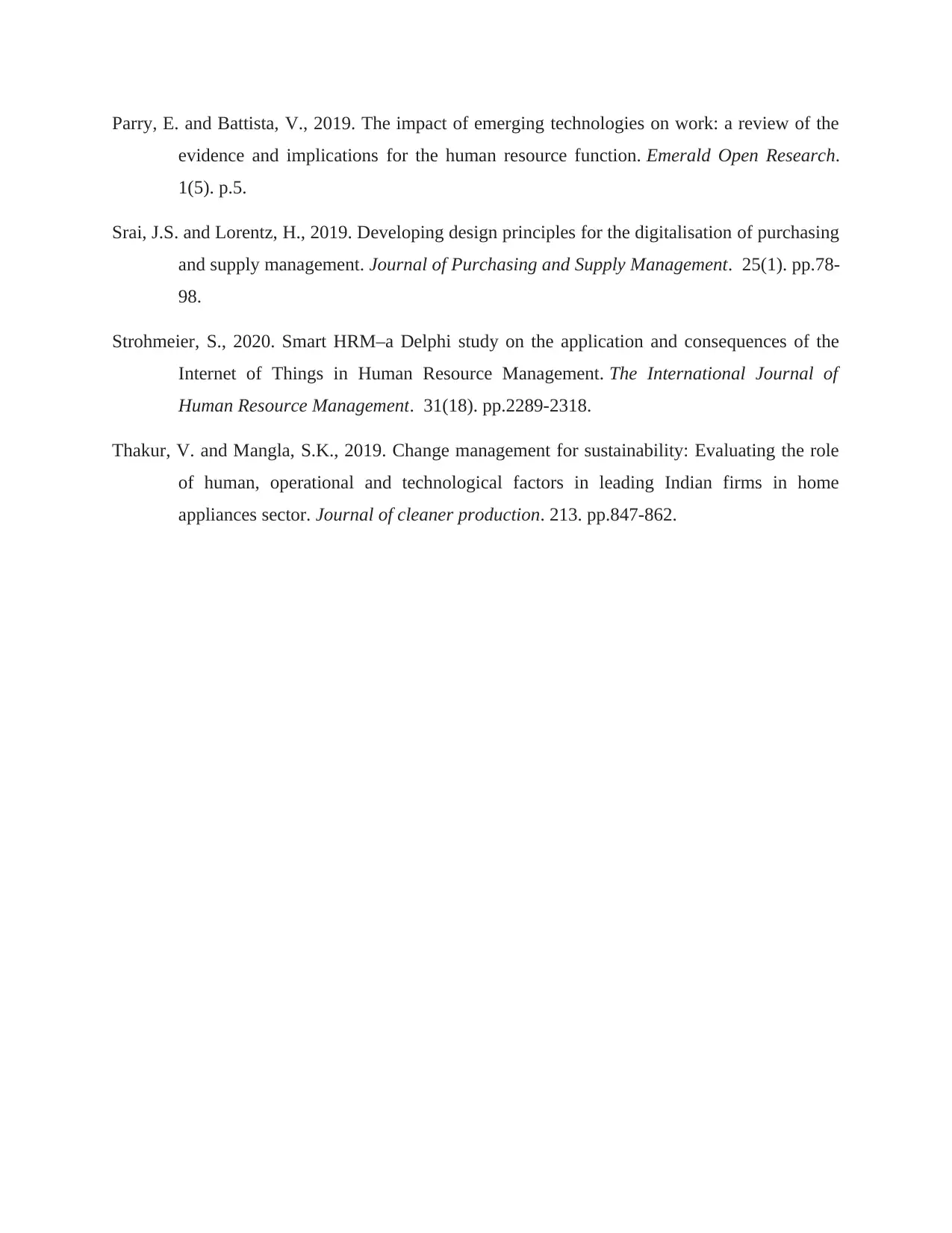
Parry, E. and Battista, V., 2019. The impact of emerging technologies on work: a review of the
evidence and implications for the human resource function. Emerald Open Research.
1(5). p.5.
Srai, J.S. and Lorentz, H., 2019. Developing design principles for the digitalisation of purchasing
and supply management. Journal of Purchasing and Supply Management. 25(1). pp.78-
98.
Strohmeier, S., 2020. Smart HRM–a Delphi study on the application and consequences of the
Internet of Things in Human Resource Management. The International Journal of
Human Resource Management. 31(18). pp.2289-2318.
Thakur, V. and Mangla, S.K., 2019. Change management for sustainability: Evaluating the role
of human, operational and technological factors in leading Indian firms in home
appliances sector. Journal of cleaner production. 213. pp.847-862.
evidence and implications for the human resource function. Emerald Open Research.
1(5). p.5.
Srai, J.S. and Lorentz, H., 2019. Developing design principles for the digitalisation of purchasing
and supply management. Journal of Purchasing and Supply Management. 25(1). pp.78-
98.
Strohmeier, S., 2020. Smart HRM–a Delphi study on the application and consequences of the
Internet of Things in Human Resource Management. The International Journal of
Human Resource Management. 31(18). pp.2289-2318.
Thakur, V. and Mangla, S.K., 2019. Change management for sustainability: Evaluating the role
of human, operational and technological factors in leading Indian firms in home
appliances sector. Journal of cleaner production. 213. pp.847-862.
⊘ This is a preview!⊘
Do you want full access?
Subscribe today to unlock all pages.

Trusted by 1+ million students worldwide
1 out of 9
Related Documents
Your All-in-One AI-Powered Toolkit for Academic Success.
+13062052269
info@desklib.com
Available 24*7 on WhatsApp / Email
![[object Object]](/_next/static/media/star-bottom.7253800d.svg)
Unlock your academic potential
Copyright © 2020–2025 A2Z Services. All Rights Reserved. Developed and managed by ZUCOL.





